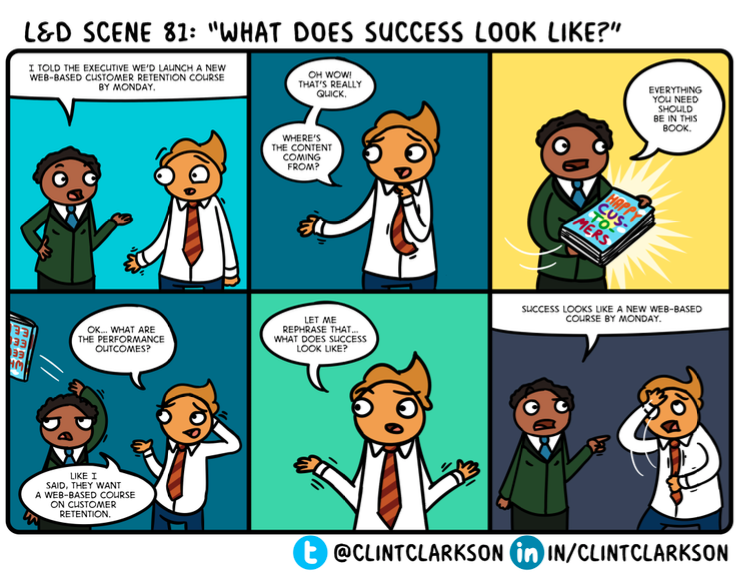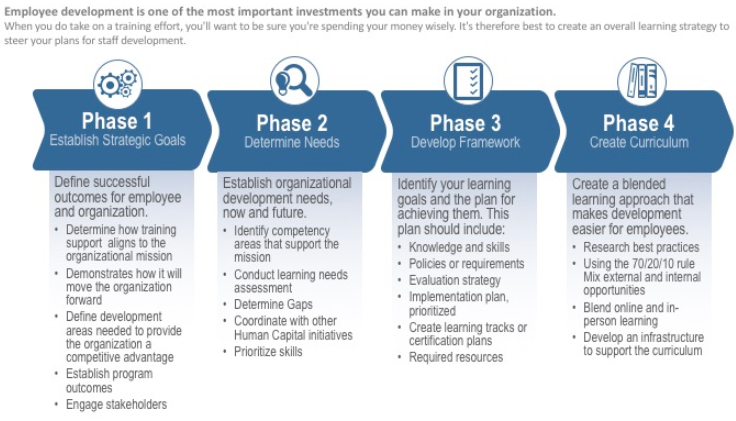Creating a Learning Strategy that Gets Results
October 3, 2018 in Learning
By Kathleen Bellis
 My colleague, Clint Clarkson, has a wonderful way of depicting a learning manager’s struggles! Surely enough, those who work in the Learning and Development (L&D) space, have, at some point, felt bombarded by training requests from clients. From new initiatives to compliance requirements to onboarding -all while keeping employees updated on technology – adds up to a lot to focus on! All in all, there’s usually more than enough to fill our plates!
My colleague, Clint Clarkson, has a wonderful way of depicting a learning manager’s struggles! Surely enough, those who work in the Learning and Development (L&D) space, have, at some point, felt bombarded by training requests from clients. From new initiatives to compliance requirements to onboarding -all while keeping employees updated on technology – adds up to a lot to focus on! All in all, there’s usually more than enough to fill our plates!
It is essential, however, to set aside time to think about the big picture and define how each component of a learning strategy will support the organization’s mission and ensure its success. By getting the right people involved, and by using a systematic approach, you’ll be on your way to implementing a successful organizational learning strategy.
This is the first in a series of learning blogs from FMP’s Learning and Development Center of Excellence. Over the next few weeks, we will present some practical ways to plan and implement learning across your organization. First, we’ll present a framework for creating an organizational learning strategy – the foundation of equipping your workforce for success.
The Right People
Before you start working through your strategy, think about the people you’ll need to involve. Getting input early and often from senior leaders will help ensure that your strategy is supported…and funded! Leaders from human resources and operations have the “5,000-foot view” of where the organization is going and how the workforce will need to support that journey moving forward. They are instrumental in helping learning managers understand what success looks like. Consider also involving some managers from outside your training division, perhaps a few individuals who you know will be advocates for learning in your organization. These are your Learning Champions! They are in the right position to highly influence your learning culture. Finally, involve a variety of your team members who will be responsible for carrying out whatever vision you create. These could be instructional system designers (ISDs), human resources managers, Learning Management System (LMS) or website owners, or other instructors.
The Right Process

Phase 1: Establish Strategic Goals
At the end of the day, a learning program won’t be measured by the number of courses it produces! It will be measured by how well equipped the workforce is to move the organization toward completing its mission. Begin with the end in mind and then define what employee performance will look like in one year, 3 years and 5 years to support this mission. Look for overall gaps between current employee skills and future requirements. Show how upskilling the workforce technically, and building leadership skills, directly aligns with the mission. Analyze workforce culture and research skills needed in the current environment such as innovation, new technology, and managing diversity. Then, define your learning program outcomes and show how they logically align with workforce development needs and successful organizational outcomes. Remember that the outcomes you define during this step will be how your program is measured later.

The result of establishing strategic goals should be a document and/or graphic representation of where your learning strategy will take you. Circulate these goals to stakeholders to make sure that you have their support. Stop here for a moment to ask yourself whether there are some items that are worth tackling right away with your existing resources!
Phase 2: Determine Learning Needs
Once you have gathered the right people, and defined learning goals, it’s time to take a good look at where you are now. Does a competency model exist? If so, does it support the outcomes you defined in Step 1? If not, it may be time to do some revising. When’s the last time you conducted a learning needs assessment? Assessing employees on competencies, as well as on their perceived training needs, enables you to find the gaps between where you are now and where you want to be in the future. Solicit input from others who work in the human resources and human capital functions within your organization. Ask them what workforce culture, performance management, or succession planning initiatives require employees to develop knowledge and skills that will be supported by your learning strategy. Once you have defined the gaps and organizational goals, prioritize which ones are immediate needs and which are longer term.

Develop a map of knowledge and skill needs according to their priority and, again, take the time to have your Learning Champions give their input. Take a step back and make sure that this map flows logically into organizational outcomes and that the knowledge and skills you’ve defined are measurable.
Phase 3: Develop Framework
Once you have established clearly defined strategic goals and learning needs, your next step is to develop a framework that defines which knowledge and skills will be developed according to the defined logical grouping of employees. Depending on what makes the most sense for you, you can group skill development paths according to job function, pay band, or technical skill area. In this description, be sure to include what knowledge and skills will be required as part of a certification or compliance training program. Then, define the resources (e.g., designers, instructors, technology-such as an LMS or multimedia tools, facilities) will be needed to support the rollout of your plan. Begin the process of budget planning and advocacy for the resources you will need, and make sure that the implementation plan aligns with organizational priorities and realistic constraints.

Produce a Strategic Learning Framework document that contains graphic and text descriptions of knowledge and skill requirements for job categories. Show progression where knowledge and skill development will happen on a continuum. Describe your learning evaluation plan and clearly show how it ties to organizational outcomes.
Phase 4: Create Curriculum
Now comes the fun part! It’s time to get creative and paint a picture of what learning will look like for the next few years. You’ve established strong outcomes related to organizational success, as well as define the knowledge and skills that will take your workforce there. Thankfully, the learning industry is filled with some high-level publications and some serious thinkers. Take time to do a little research on best practices. Does it make sense to integrate things like personalized learning, gamification, and/or microlearning into your plan? Is it time to think beyond the classroom and begin using technology in learning for the first time?
When creating your curriculum, use the 70/20/10 Model.This model, based on research by the Center for Creative Leadership, describes the optimal sources of learning. It holds that individuals obtain 70 percent of their knowledge from job-related experiences, 20 percent from interactions with others, and 10 percent from formal educational events.

The Curriculum Map is the roadmap you will use to guide your learning strategy over the next few years. Make it a living document that guides your learning staff and communicate this curriculum often to employees through mechanisms such as your Learning Management System and employee communication forums such as Sharepoint.
Final Tips
- Communicate – As important is it is to involve the right people in developing your learning strategy, it is just as important to communicate that strategy, and its components, early and often. For example, one client, a large financial institution, embarked on a major culture shift as part of their growth strategy. They defined the characteristics of their organizational culture and the learning strategies that would support it. Throughout their headquarters and field office, large banners pointed to this vision, and all of their learning offerings were branded and shared with employees frequently. There was a sense of excitement around learning that was offered at this organization, and you could clearly see an impact on the culture. Don’t forget to involve a graphic designer. Work with them to develop clear and crisp graphics and branding that depicts components of your strategy that you are communicating to a wider audience.
- Using a phased implementation approach – There are certainly many steps involved in developing a great learning strategy and curriculum, but they can’t be developed or implemented all at once. Just like building and decorating your dream home, the walls, doors, and appliances all have to be present before you can even think about the carpet and curtains. Be realistic about what can be accomplished with your given resources and continue to build support and buy-in for the future.
- Consider your timeframe – The problem some of us run into when trying to develop a strategy like this is that it can take time. The great news is that 1) the process is iterative – you can start implementing some pieces before others are developed in order to see some immediate results, and 2) some steps can be concurrent. For example, you can start Phase 2 while you are working on Phase 1. Begin a needs assessment or revise your competency model as you are developing strategic goals and establishing your stakeholder support and Learning Champions.
- Measure, measure, measure! – You’ve worked hard to create a logical connection between how your curriculum ties to organizational outcomes and learner needs. Ensure that you measure, track, and communicate these results and use them to embark on a continuous improvement plan
- Keep it agile – If we know one thing for sure about organizational dynamics today, it is that change is a given! Aim to keep communication strategies, evaluation methods, and learning content and methodologies fluid so that your program keeps up with the times.
In our next few blogs, we’ll dive a little deeper into learning strategy as we explore research and best practices for Creating Learning Culture, Selecting Tools for Learning, Keeping Learning Agile, and Learning Evaluation.
Author: Kathleen Bellis, MA is an Engagement Manager at FMP.